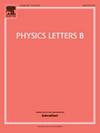Nuclear α-cluster structures from valence-space microscopic cluster model
IF 4.3
2区 物理与天体物理
Q1 ASTRONOMY & ASTROPHYSICS
引用次数: 0
Abstract
Alpha clustering is an important dynamic in nuclear physics, with growing interest to its study in heavy nuclei in recent years. Theoretically, the microscopic cluster models taking nucleons as relevant degrees of freedom have been widely used to study α-cluster structures in light nuclei. However, a straightforward application on same footing in heavy nuclei is obstructed by the complexity of handling numerous nucleons. As a simplified alternative, the macroscopic cluster models built upon cluster degrees of freedom are usually employed in heavy nuclei, though these approaches typically lose several critical structural details. In this work, we propose to study the α-cluster structures within the framework of valence-space microscopic cluster model (VS-MCM), which is a hybrid between microscopic and macroscopic cluster models and inherits features from both models, making it capable to investigate the α-cluster structures in heavy nuclei from a relatively microscopic viewpoint. In VS-MCM, the valence α clusters are described by antisymmetrized microscopic wave functions, with single-particle orbits in core nuclei removed systematically from the model space via the Pauli projection to simulate the antisymmetrization between α clusters and doubly magic cores. As a proof of principle, we apply the VS-MCM to study the α-cluster structures in 20Ne and 44Ti at first, with the theoretical energy levels of the bands for 20Ne and 44Ti showing reasonable agreement with experimental data. These calculations lay the foundation for future applications of VS-MCM in general cluster structures across the nuclide chart, where more α clusters and valence nucleons can exist outside the heavy doubly magic core, opening new avenues to study the α and cluster decays in heavy nuclei microscopically.
价空间微观团簇模型的核α-团簇结构
α聚类是核物理中一个重要的动力学现象,近年来在重核中的研究日益受到关注。理论上,以核子为相关自由度的微观团簇模型已被广泛用于研究轻核中的α-团簇结构。然而,由于处理大量核子的复杂性,在相同基础上对重核的直接应用受到阻碍。作为一种简化的选择,建立在聚类自由度上的宏观聚类模型通常用于重核,尽管这些方法通常会丢失一些关键的结构细节。本文提出在价空间微观团簇模型(VS-MCM)框架内研究α-团簇结构,该模型是微观和宏观团簇模型的混合体,继承了两者的特点,能够从相对微观的角度研究重核中α-团簇结构。在VS-MCM中,价α团簇用反对称的微观波函数来描述,通过泡利投影系统地从模型空间中去除核心核中的单粒子轨道,模拟α团簇与双幻核之间的反对称。作为原理证明,我们首先应用VS-MCM研究了20Ne和44Ti的α-团簇结构,20Ne和44Ti的Kπ=01±波段的理论能级与实验数据符合得很好。这些计算为今后将VS-MCM应用于核素图上的一般团簇结构奠定了基础,其中更多的α团簇和价核子可以存在于重双魔核外,为重核中α和团簇衰变的微观研究开辟了新的途径。
本文章由计算机程序翻译,如有差异,请以英文原文为准。
求助全文
约1分钟内获得全文
求助全文
来源期刊

Physics Letters B
物理-物理:综合
CiteScore
9.10
自引率
6.80%
发文量
647
审稿时长
3 months
期刊介绍:
Physics Letters B ensures the rapid publication of important new results in particle physics, nuclear physics and cosmology. Specialized editors are responsible for contributions in experimental nuclear physics, theoretical nuclear physics, experimental high-energy physics, theoretical high-energy physics, and astrophysics.
 求助内容:
求助内容: 应助结果提醒方式:
应助结果提醒方式:


